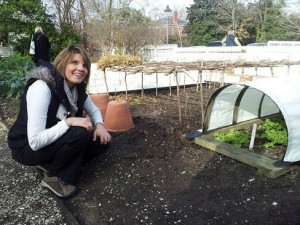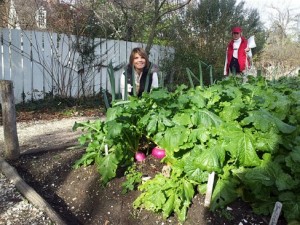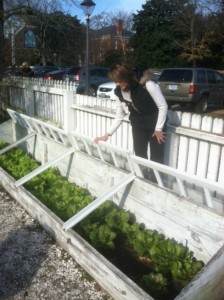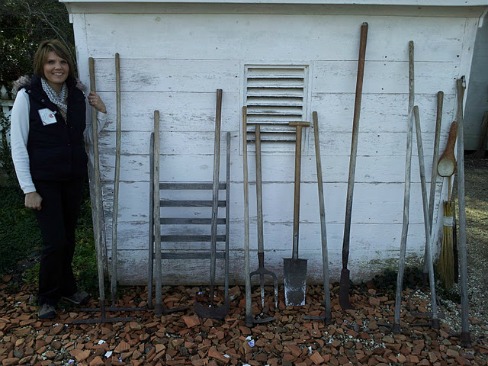 Can you imagine gardening in the 18th century? If not, I suggest you visit Colonial Williamsburg in Virginia. Historians have done a fantastic job re-creating early American gardens. Garden historians have used the writings of John Randolph who pinned, A Treatise on Gardening in 1793, as a guide to rebuilding the Williamsburg gardens. Here is a snippet of Mr. Randolph’s advice to the 18th century gardeners, including many of our founding fathers:
Can you imagine gardening in the 18th century? If not, I suggest you visit Colonial Williamsburg in Virginia. Historians have done a fantastic job re-creating early American gardens. Garden historians have used the writings of John Randolph who pinned, A Treatise on Gardening in 1793, as a guide to rebuilding the Williamsburg gardens. Here is a snippet of Mr. Randolph’s advice to the 18th century gardeners, including many of our founding fathers:
“January. Prepare, hot beds for cucumbers; as little can be done this month in the garden, I would advise the preparing of your dung, and carrying it to your beds, that it may be ready to be spread on in February.”
I recently had the opportunity to attend a Nutrients for Life business meeting in Colonial Williamsburg. Thankfully, meeting organizers allowed time for this eager gardener to tour the historical area. There are twenty-six gardens available for viewing in the Colonial Williamsburg district. I had time to visit one, which gives me the excuse to plan a family vacation to tour the other twenty-five when they are in full bloom. (I admit, it’s not as exciting as Disney, but it is a moment in American history that is worthy of an educational family vacation.)
I wasn’t sure what to expect in early December in a Zone 7 garden; to my delight, the Colonial Garden and Nursery was full of cold hardy crops. As I walked through the garden, which I would describe as simple and functional, I saw rows of cabbage, cauliflower, beets, lettuce, and then a huge thistle. Upon further review and a question answer session with the gardener, I was corrected. The large thistle-looking plant was actually a type of artichoke called chardoon. Fascinating information (and I’m not being sarcastic)! Chardoon is eaten like celery, however not as tasty, which is why it’s not commonly seen in any of our gardens.
 The garden plants were protected from the frigid air with bell jars, hoop covers, and cold frames. I was impressed with how much they had growing and felt a little ashamed of my winter garden – well actually, I don’t even have a winter garden! The Colonial Garden and Nursery was an excellent example of what a winter garden could be. In support of my non-existent winter garden, they have two full time garden historians (dream job) each working forty-hours a week in this garden.
The garden plants were protected from the frigid air with bell jars, hoop covers, and cold frames. I was impressed with how much they had growing and felt a little ashamed of my winter garden – well actually, I don’t even have a winter garden! The Colonial Garden and Nursery was an excellent example of what a winter garden could be. In support of my non-existent winter garden, they have two full time garden historians (dream job) each working forty-hours a week in this garden.
The historical significance of these gardens are promoted by M. Kent Brinkley and Gordon W. Chappell in their book, The Gardens of Colonial Williamsburg. (A great read prior to your visit the historical area, however it proved to be a bit boring for my two, five, and ten-year-old girls.)
I pause and consider that as our Nation’s political framework was being created, our founding fathers were also involved in their own food production. Their survival was directly tied to governing the New World and just as importantly, how to manage the land for food production.“Gardens have always been an important aspect of the Williamsburg scene, both in the eighteenth century and today when at least three generations have come to appreciate this town and its gardens as an integral part of America’s historical heritage. Colonial Williamsburg’s political and historical legacy is well known, but despite its popularity, relatively few realize that in addition to being an important political and cultural center in eighteenth-century Virginia, Williamsburg was a center of gardening activity.”

I personally don’t think the basics of gardening in the 18th century is all that different than in the 21st century. Gardening has evolved but the basics of preparing the seedbed; germinating seeds and caring for a plant remain similar. It’s the same environment and soil that John Randolph wrote about in 1793. The soil continues to be the main ingredient to a garden’s success. As Mr. Randolph suggested, soil fertility is key to a bountiful harvest. If all the nutrients have been pulled from the soil, they must be replenished in some way.
Although the basics of gardening remains the same, the way we eat is radically different than in the 18th century. Thank goodness, I don’t have to grow and preserve enough food to last our family the entire year…I can barely keep up with the laundry.
As this nation became less agrarian, science and technology allowed production agriculture to be more precise and accurate at managing soil fertility and more efficient at raising the crops that feed the seven billion mouths inhabiting this earth.
For example, materials like dung that Mr. Randolph mentioned, animal remains, and potash salts made from wood ashes were the primary ingredients used to replace nutrients in the soil. Farmers relied on whatever was available locally. During the Industrial Revolution, more reliable fertilizers were produced and farmers now have additional options to maintaining soil fertility. In addition to better products, farmers have GPS-guided machinery and precise fertilizer blends to appropriately use every nutrient applied to the soil.
As our current policy makers continue to make and change policy, I hope they will continue to remember, as our founding fathers (gardeners) knew, how valuable our soil is in feeding this great Nation. I’m reminded of a Norman Borlaug quote: “Civilization as it is known today could not have evolved, nor can it survive, without an adequate food supply.”






Enjoyed your recap of Williamsberg gardens–Just wanted you to know that i am reading your blog
Wow! I would love to visit! Thanks for sharing!